Most of Oklahoma’s 12 million acres of forests are owned by private individuals, not the federal government or large companies. These forests mostly consist of oak-hickory trees, which are used for commercial wood products in northeastern Oklahoma. In the western and southern areas of the state, rainfall is less, and hickory becomes rarer. The most valuable wood is from the oak-pine forests in the southeastern corner of Oklahoma, which are owned by the forest industry and private landowners. The federal government owns about 300,000 acres.
Forests are essential for the wildlife of Oklahoma, providing shelter from extreme temperatures, food sources such as nuts and fruits, and a place to raise young. Forests also provide a habitat for many species of birds that migrate through the state each year. Additionally, forests can help regulate air quality by filtering out pollutants in the atmosphere. For all these reasons, protecting our forests is key to preserving the rich biodiversity in Oklahoma’s natural landscapes.
1. Blackjack Oak
Blackjack oak, native to Oklahoma, is a species of oak that grows up to 50 feet tall. They typically grow naturally on dry soil that is not nutrient rich. In Oklahoma, it is often found in areas that are too dry for many types of oak trees to survive.
Acorns from the Blackjack oak are an important food source for mammals such as fox squirrels and birds, which are high in fat content. Its wood is hard and heavy with strong grain patterns making it ideal for fence posts, railroad ties, and firewood.

©Sandyjim/Shutterstock.com
2. Pinyon Pine
Pinyon pine trees are native to western Oklahoma. They often grow as a low, shrubby-looking tree with a round but irregular crown. The typical height is 25-55 feet, with a crooked trunk. They are slow growing but long-lived. They live up to 500 years, with some individuals reaching 1,000 years of age!
Pinyon pine produces wingless seeds that are spread about the forest by birds, squirrels, and chipmunks. They are a favorite food of Clark’s nutcrackers, scrub jays, pinyon jays, and Steller’s jays. Scrub jays live permanently inside pinyon/juniper forests and live on large amounts of pinyon pine seeds.

©iStock.com/Ana Iacob
3. Juniper
Juniper (Juniperus monosperma) is a tree native to Oklahoma. This evergreen is grown as a small tree or large shrub and reaches around 25 feet tall. It has exfoliating bark that hands off of the tree in long strips to reveal the orange underbark. The tree produces dark blue cones that look like berries and have a waxy covering. The seeds inside the cones are a favorite food of many birds and small mammals. Chipmunks and rock squirrels love them, and deer eat the entire cone.
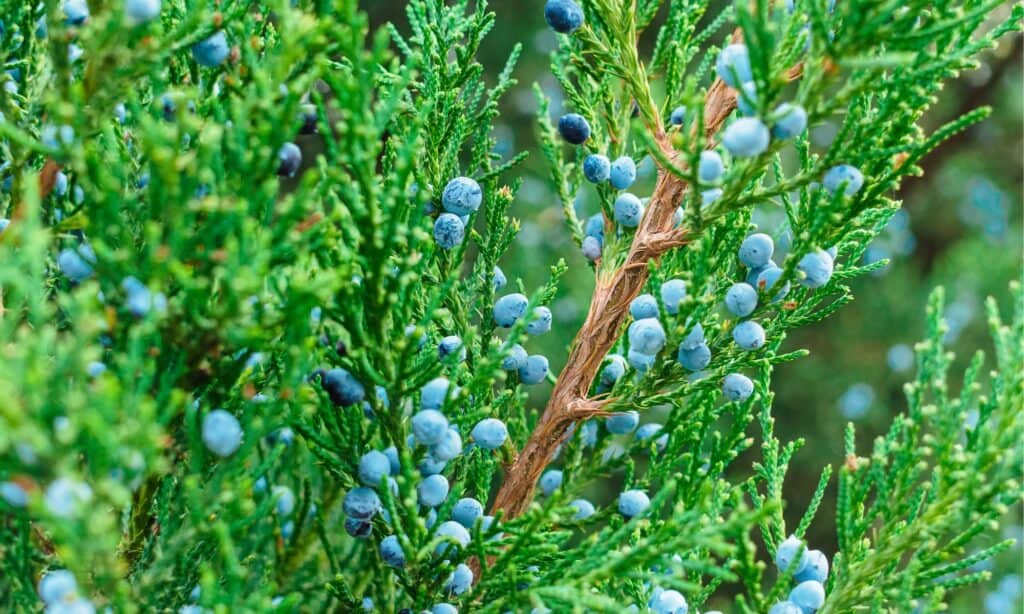
©iStock.com/Yuliya Shauerman
4. Bald Cypress
This tall Oklahoma native tree will become a russet or copper color in the autumn and can reach up to 70 feet in height with a 30-foot spread. It can survive in both wet and dry conditions, so it makes a good choice as a specimen, street tree, or as part of a pond-side grove. Furthermore, many amphibians, such as frogs, toads, and salamanders, use Bald Cypress trees as breeding grounds, which is why they are essential to the local environment.

©Silvio Ligutti/Shutterstock.com
5. Willow Oak
The willow oak is a deciduous tree native to Oklahoma. It has a tall, straight trunk that can grow up to 120 feet tall and starts producing acorns when it is only 20 years old. These acorns are a preferred food of many wildlife species, such as wild turkeys, woodpeckers, flickers, grackles, deer, foxes, and squirrels. Blue jays have been known to transport the seeds of the Willow Oak for miles from their original location to help spread its numbers throughout Oklahoma’s forests. This fact has made them an invaluable part of our local ecology and ecosystem by providing sustenance for many animals.
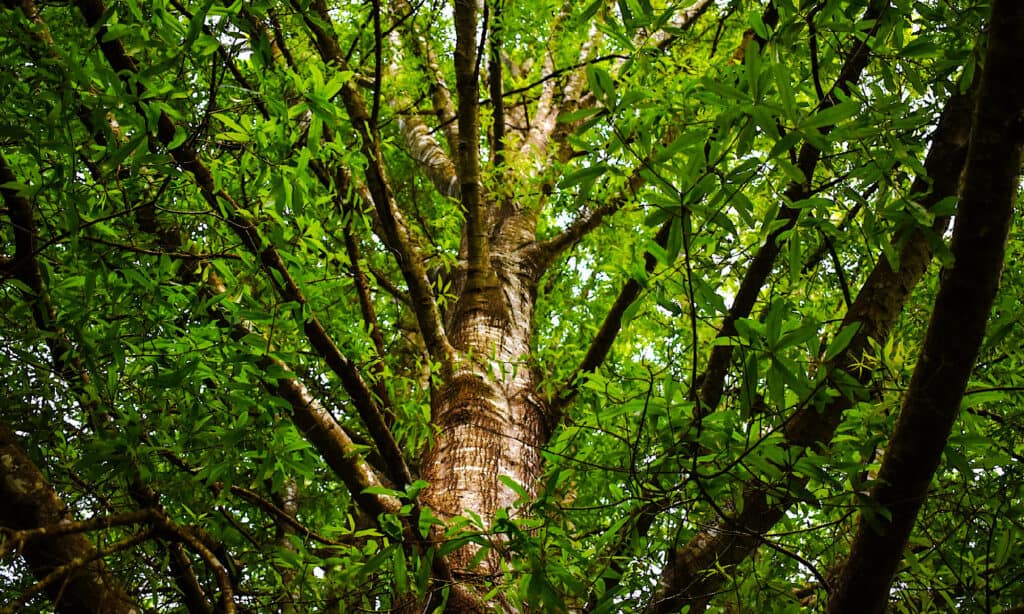
©iStock.com/Caytlin Endicott
6. Pin Oak
Pin oak is a fast-growing deciduous tree native to Oklahoma. It grows to an impressive 120 feet tall. However, the most common height is 80 feet. Its wide symmetrical crown produces half-inch-long acorns that provide vital nutrition for migrating wood ducks and mallards during their migration in the late fall. Pin oaks are also good food sources for deer, wild turkeys, woodpeckers, squirrels, and bluejays. During flooding, pin oaks provide shelter and nesting opportunities for many animals near the water. The versatility of this species makes it a valuable asset to many ecosystems in Oklahoma.
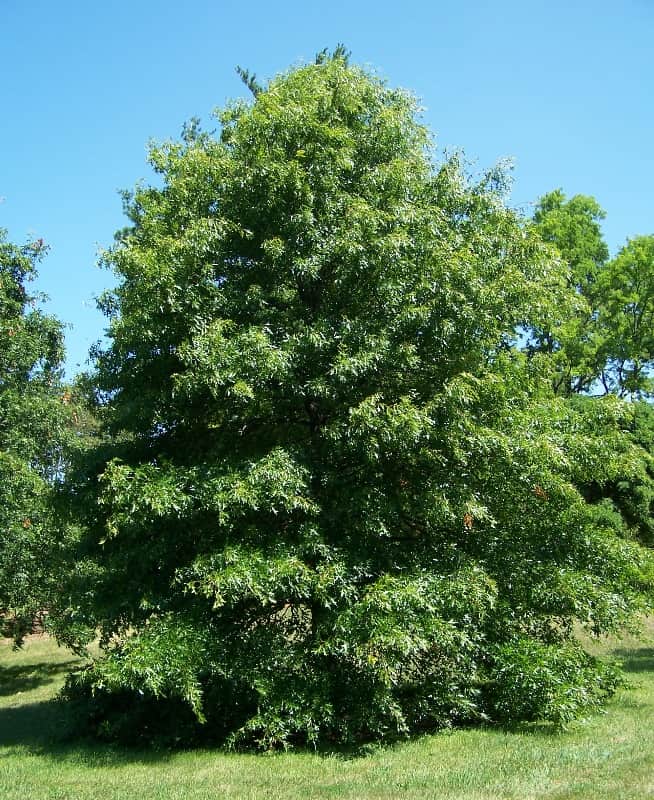
©Bruce Marlin / CC BY-SA 2.5 – License
7. Shortleaf Pine
Shortleaf pine is a native species of Oklahoma and can be found in the eastern quarter of the state and at the western fringes. It is an incredibly hardy tree that can withstand droughts, rocky soils, ice, and strong winds better than other trees. Its ability to sprout following fire makes it especially suitable for dealing with climate change. When mature, shortleaf pine can reach up to 100 feet tall and has dull brown cones shaped like eggs.
Shortleaf pines are incredibly beneficial for wildlife due to their high habitat value. Many animals rely on the trees for shelter and food, making them a much-needed resource. Shortleaf forests provide an ideal home for bobwhite quail, northern bobwhite, woodpeckers, whitetail deer, northern cardinal, indigo bunting, fox squirrels, and more.
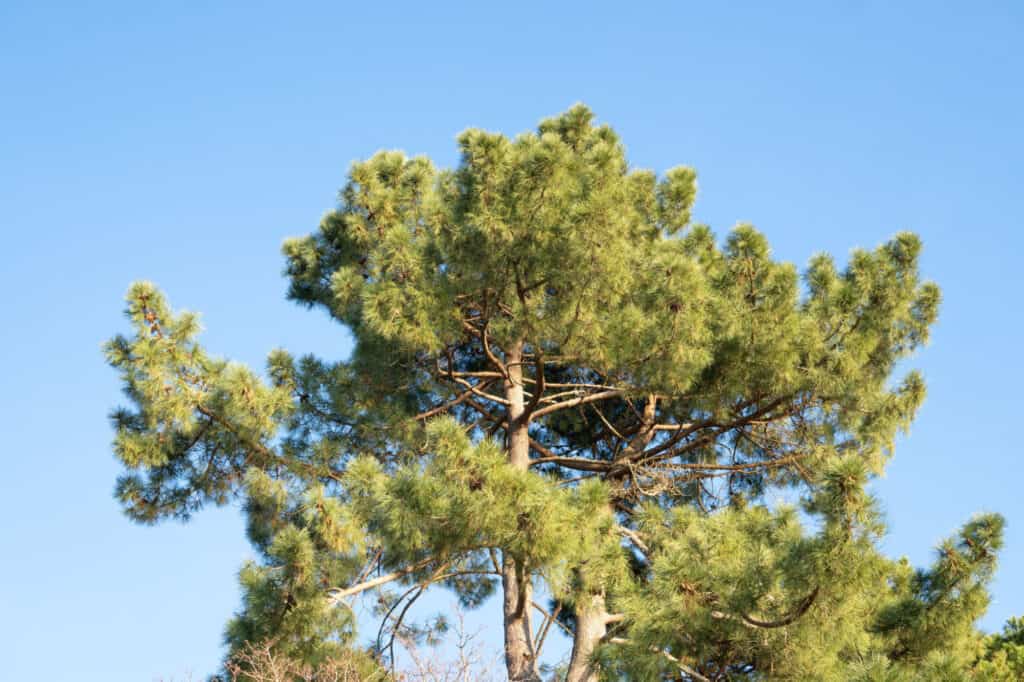
©Formatoriginal/Shutterstock.com
8. Pecan
Pecan trees are native to Oklahoma and make a stunning addition to any landscape, with their thick gray-brown trunks and rounded canopies that spread up to 60 feet. The bark of the pecan tree is ridged and scaly in appearance, and the edible nuts are a big attraction.
Blue jays love pecans, while raccoons, possums, mice, hogs, and cattle also munch on them in the fall. Even insects, like ants and stinkbugs, rely on pecan trees for survival.
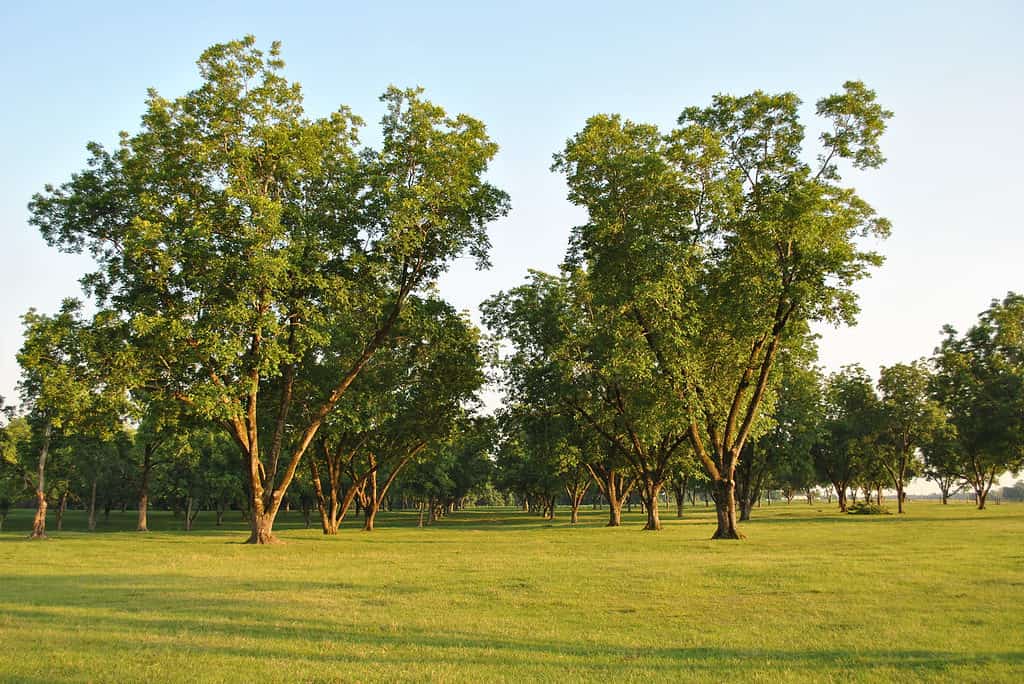
©Tayloradempsey/Shutterstock.com
9. Cottonwood
Cottonwood trees are a common sight in Oklahoma and the surrounding states. Several species of Populus, which belong to the family Salicaceae, make up this genus of fast-growing trees. The leaves are typically triangular with toothed edges and release a cottony seed when mature. When wind passes through these dangling leaves, they clatter together, making an interesting sound. Cottonwoods can grow quite large – up to 100 feet tall – and have thick, shiny leaves.
The hollowed-out trunks provide ideal winter hibernation sites for black bears and other cavity nesters such as bats. In addition, many animals will feed on the bark or leaves of these trees, including mice, rabbits, and deer. Lastly, birds also benefit from these majestic giants by using them as roosting sites for songbirds or gamebirds alike!
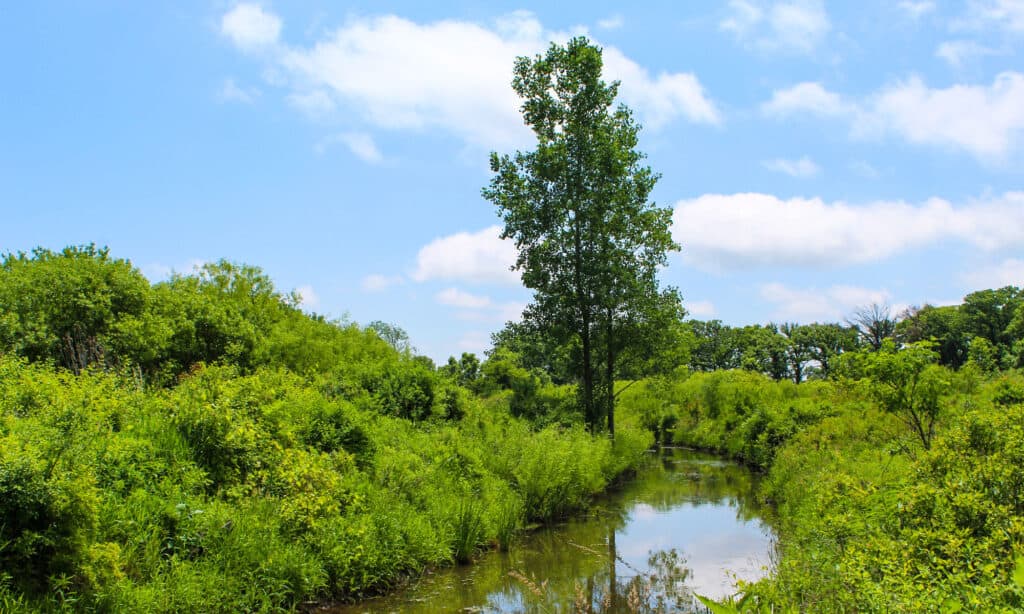
©John Ruberry/Shutterstock.com
10. Green Ash
Green ash is a native tree to Oklahoma and can grow up to 70 feet or more in height. Its round crown spreads outwards, providing plenty of shade for the environment beneath it. It produces samaras that are 2 inches long, each containing one seed.
These seeds provide food for small animal species such as rabbits. The green ash tree also provides shelter and nesting sites for bird species, including blackbirds, finches, grosbeaks, and cardinals which feed on its fruits. This tree prefers areas with more than 20 inches of precipitation per year, often growing together with other trees like pecan, cottonwood, black willow, and elm trees, which form an integral part of its ecosystem.
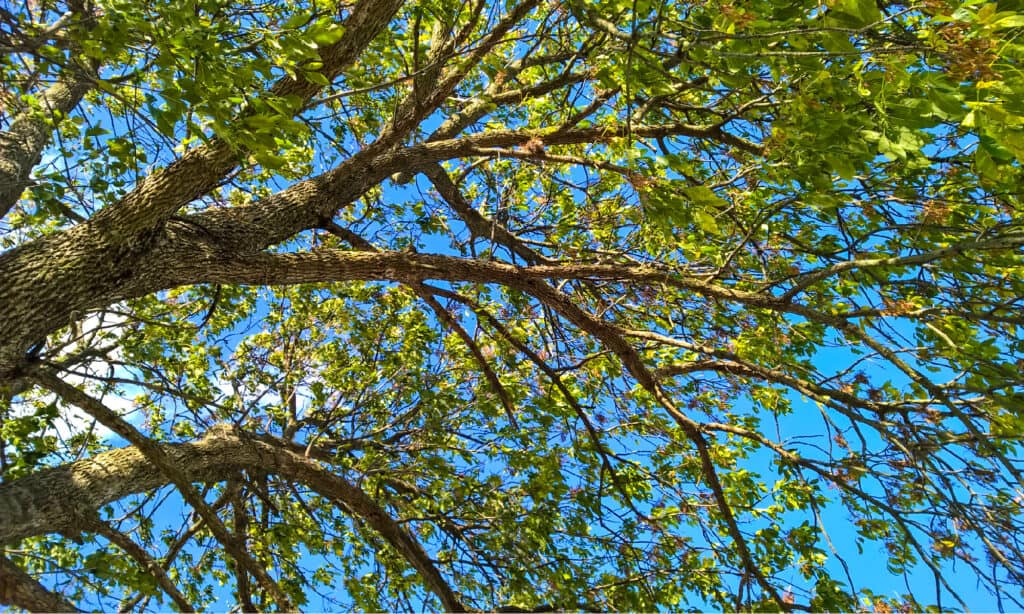
©iStock.com/Ethan R.
Why Plant Native?
Native trees are better than non-native trees for a variety of reasons. For one, native trees have adapted to the climate and soil conditions in Oklahoma over time, making them more resilient to extreme weather events such as droughts or floods. Native tree species tend to require less maintenance as they are used to the local environment and can usually survive without extra care. Additionally, planting native species helps restore natural ecosystems by providing food and shelter for many wildlife species that live in Oklahoma. Finally, using native plants reduces competition with invasive species which can be detrimental to both our local habitats and economy.
Summary of 10 Trees Native to Oklahoma
- Blackjack Oak
- Pinyon Pine
- Juniper
- Bald Cypress
- Willow Oak
- Pin Oak
- Shortleaf Pine
- Pecan
- Cottonwood
- Green Ash
Next Up
The post 10 Beautiful Trees Native to Oklahoma appeared first on AZ Animals.
from Animal News, Facts, Rankings, and More! - AZ Animals https://ift.tt/Y4jHyxi